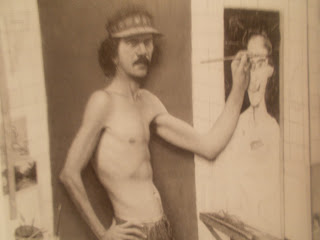Tuesday, October 16, 2012
23) Unity with Variety
Using many different shapes and object throught the design while still being able to unify it. The quilt above shows this use of variety to unify the overall design.
22) Unity through Continuity
Is starting out with and idea in a design and continueing that all throughout the design. The image of a magazine spread shows this continuity of the design in the two pages.
21) Unity through Continuation
Is continueing the design by using elements that keep your eye moving through the design. The image above shows this continuation by the figures forming a circular ring.
20) Unity through Repetition
Giving the design unity by repeating a shape over and over throughout the design. The image above shows this repetition by repeationg the same object in the figure.
19) Unity through Proximity
Is grouping object in the design giving it unity by bringing things close together. The image shows this by grouping the men together in the mid-ground of the image.
18) Visual Texture
Is the ability of the artist to convey texture in the design without being able to feel it. This image shows this texture by the way the ladies dress crinkles at the end.
17) Tactile Texture
Is a texture used in a painting that can actually be felt. My example can not be since it is a photograph of the original work, but you get the feeling of depth through texture.
16) Value as Emphasis
Is the ability to use dark and lights to protray the focal point of the design. The image above shows this by protraying the women on the left in black and the girl on the right in white.
Monday, October 15, 2012
15) Value as Pattern
Is a design that uses pattern as the theme of the design to protray the image. The repetition of the same pattern in the background gives the feeling of a crowd of people.
14) Curvilinear Shapes
Are shapes that curve and flow on the design instead of ridiged square shapes. The design shown uses these circular shapes to give a feeling of flow.
13) Rectilinear Shapes
Are shapes that protray rectangles and squares all through out the design. The design shown repeats these rectangular shapes throughout the image.
12) Nonobjective Shapes
Are shapes that do not protray a real life object to make a design but rather still forms a design just not a identifiable one.
11) Abstraction
Is a design concept that uses different shapes, objects and colors to make a design out of nothing .
10) Idealism
Is the idea of what we want something or someone to look at when we present it in a design. The statue above shows this idealism of man.
8) Natuarlism
Is when the design is portraying a real figure or object and is tranferred over while not loosing the true aspects of the object.
7) Lost and Found Contour
5) Gesture Line
Gesture is used to convey motion instead of shapes giving the design action like seen in this example.
4) Contour Line
Contour lines is a design concept that conforms to the image at hand you are making. Example shown shows the contour lines bieng the people.
2) Line Direction
Line and direction is a design used in art that draws the eye to the emphasis of the artwork by conveying a feeling of motion. This example shows that direction as the two fighters swing toward each other.
Subscribe to:
Comments (Atom)




















